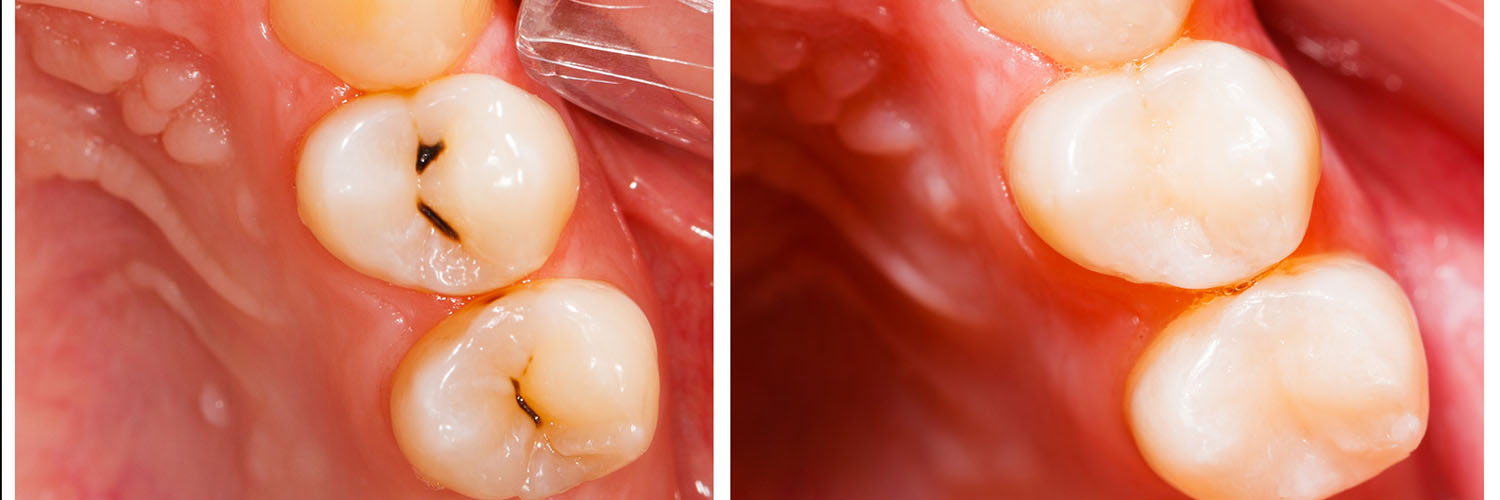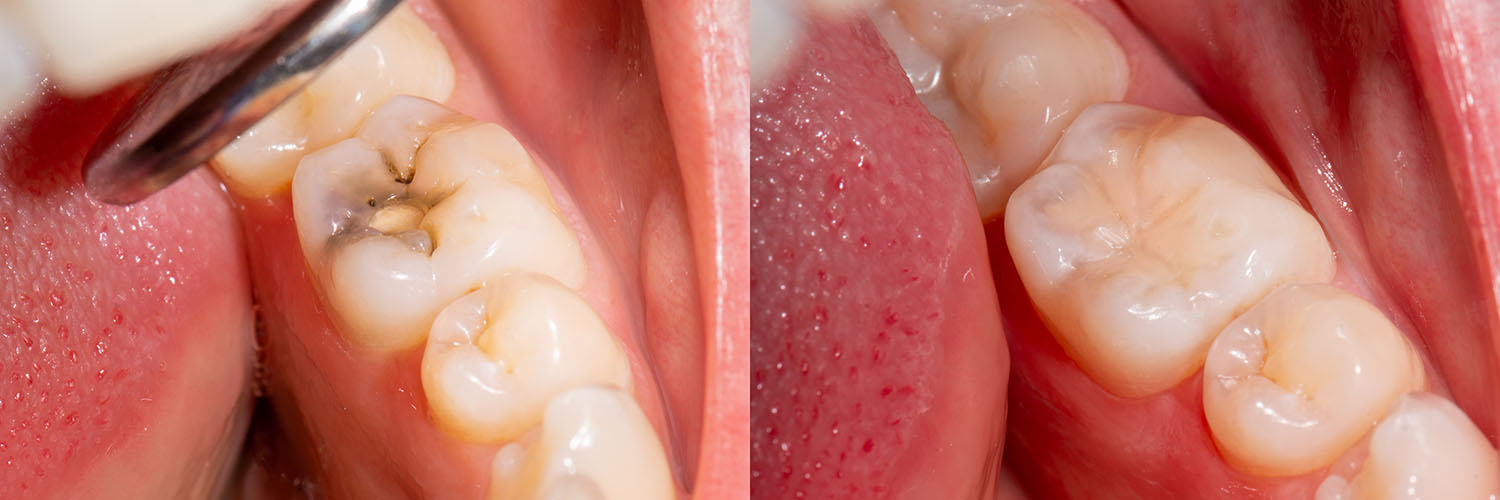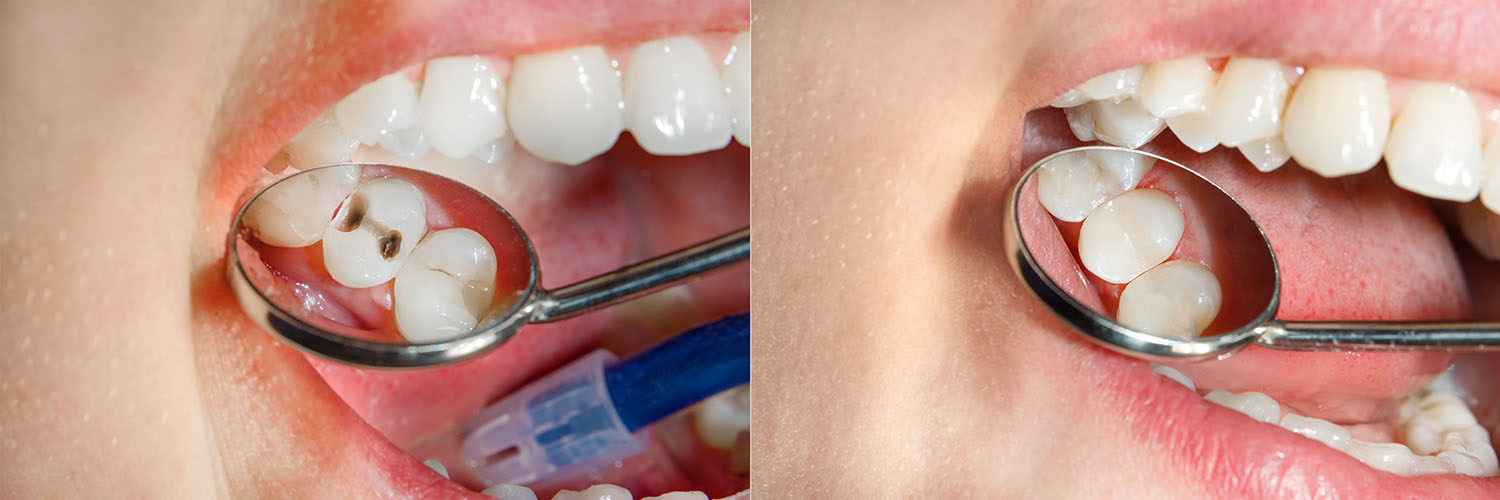Existing Patients
(740) 344-4549
New Patients
(740) 212-1897

Dental fillings do more than simply fill a hole — they rebuild a tooth's shape, restore chewing function, and protect vulnerable tissues from further decay. When decay or trauma removes healthy enamel and dentin, a well-placed filling reestablishes the tooth’s integrity so it can withstand normal biting forces and resist infection. Quick intervention often means a simpler restoration and a better long-term outcome.
Today’s restorative dentistry emphasizes conservation: removing only the damaged portion of a tooth and preserving as much healthy structure as possible. This approach reduces the likelihood of future complications and helps maintain the tooth’s natural strength. Modern adhesive materials and improved bonding techniques allow clinicians to achieve durable results while minimizing unnecessary removal of tooth tissue.
At Brian Howe DDS, Family Dentistry, our philosophy is to combine careful diagnosis with precise treatment so fillings serve both functional and visual goals. We take the time to explain why a filling is recommended, what to expect during the procedure, and how each choice supports a long-lasting restoration tailored to your needs.
Repairing damaged teeth is not a new concept — people have attempted tooth restorations for millennia. Early efforts used a variety of natural materials and rudimentary tools; modern dentistry, by contrast, relies on materials science, evidence-based protocols, and strict sterilization standards. Understanding how materials evolved helps explain why today’s options are safer, more reliable, and far more aesthetic than those of past centuries.
The shift away from metal-dominant restorations toward tooth-colored, adhesive materials has largely been driven by patient preferences and material improvements. Advances in composite resins, ceramics, and glass ionomers offer predictable strength and blend seamlessly with natural teeth. These developments also allow dentists to repair teeth in a way that prioritizes appearance without sacrificing durability.

Not every filling is the same. Selection depends on the size and location of the cavity, the tooth’s role in chewing, aesthetic concerns, and the patient’s oral health history. For example, a small filling on a front tooth will generally prioritize appearance, while a large restoration on a molar must emphasize strength and wear resistance. Your dentist will weigh these factors and discuss the trade-offs for each material.
Another important consideration is how a material bonds to the tooth. Adhesive restoratives can reinforce weakened teeth by forming a tight seal with remaining enamel and dentin, reducing microleakage and improving longevity. In areas where adhesion is less critical or where extreme loading occurs, more robust indirect options — such as ceramic inlays or onlays — may be preferable.
We’ll always present options and explain why one choice may suit your smile better than another. The objective is to deliver a restoration that looks natural, lasts, and preserves the health of the tooth and surrounding tissues for as long as possible.
Composite fillings are made from resin combined with glass or ceramic particles, and they are available in multiple shades to match tooth color closely. Because they bond to tooth structure, composites often require less removal of healthy tissue than some traditional materials. This allows for a more conservative repair and a restoration that blends into the smile.
Composites are versatile: they repair cavities, reshape worn or chipped edges, and can be used for cosmetic bonding. They are strong for everyday use but can show wear or staining over many years, so patients should expect periodic evaluation and maintenance to ensure optimal performance.
Amalgam has a long track record for durability in large load-bearing areas, particularly in posterior teeth. These restorations are known for their longevity and resistance to fracture, which historically made them a common choice for molar restorations that must withstand heavy chewing forces.
While less commonly chosen for visible areas today because of their metallic appearance, amalgam still provides a dependable option in select clinical situations where strength and cost-effectiveness are primary concerns.
Glass ionomer materials bond chemically to the tooth and gradually release fluoride, which can help protect a restored tooth from further decay. Because of these properties, glass ionomers are often used in pediatric dentistry, for restorations near the gumline, or as temporary restorations during multi-step care.
These materials are generally less wear-resistant than composites or ceramics, so their best use is in low-stress areas or when fluoride release and a conservative bond are important clinical advantages.
Ceramic restorations are fabricated outside the mouth from high-grade dental porcelain and then bonded into place. They combine excellent aesthetics with outstanding resistance to staining and wear. Because they are made in a laboratory or milled in-office, ceramics can be shaped precisely to restore function and contour while matching the natural tooth surface.
In cases where a cavity is too large for a direct filling but not so extensive as to require a crown, an inlay or onlay offers a conservative and long-lasting solution that preserves more natural tooth structure than a full crown.
Gold remains a premium restorative material prized for its strength, longevity, and biocompatibility. Although less common in contemporary cosmetic-focused dentistry, gold restorations are extremely durable and are gentle on opposing teeth, making them a practical choice for some posterior restorations.
Gold restorations are typically fabricated as indirect restorations and require skilled laboratory work. Their cost and metallic appearance mean they are selected less frequently today, but they continue to serve as a reliable option when longevity is the priority.

A thorough evaluation begins with a clinical exam and targeted imaging to detect decay that may not be visible to the naked eye. Bitewing radiographs, intraoral cameras, and careful probing allow us to map the extent of damage and determine whether a direct filling will suffice or if a more extensive restoration is recommended. Early detection often means a simpler, more conservative repair.
Treating a cavity typically involves gently removing decayed tissue, preparing the remaining tooth for a secure restoration, and placing the selected material with attention to sealing margins and restoring proper anatomy. For most patients, local anesthesia provides a comfortable, pain-free experience during the procedure. We use contemporary instruments — including high-speed handpieces, air abrasion, or laser-assisted tools when appropriate — to remove decay precisely and efficiently.
Appointment length varies with the size and location of the repair, but many routine fillings are completed in a single visit. For larger or more complex restorations, temporary materials may be placed while final fabrication (such as a ceramic inlay) is completed. We also discuss sedation options for patients who experience dental anxiety to ensure care is calm and manageable.
Proper care immediately after a filling begins with protecting numb tissues until sensation returns. Avoid chewing on the treated side until the anesthetic wears off, and take care with hot beverages. Mild sensitivity to temperature or pressure is common for several days as the tooth adjusts, but it typically subsides on its own. If sensitivity increases or pain persists, contact your dentist to rule out complications.
Long-term success depends on daily oral hygiene and routine dental checkups. Regular brushing with fluoride toothpaste, flossing, and periodic professional cleanings reduce the risk of new decay at the margins of a filling. During checkups, your dentist will evaluate the restoration for wear, marginal breakdown, or secondary decay and recommend repair or replacement only when necessary.
Even the highest-quality filling may eventually require maintenance — whether due to normal wear, a new cavity, or changes in bite forces. When a restoration needs attention, early intervention often allows for a conservative repair rather than a more extensive procedure. We prioritize transparency about your options and strive to help each patient maintain a healthy, functional smile for years to come.
In summary, dental fillings are a cornerstone of conservative restorative care. By diagnosing problems early, choosing materials that balance strength and aesthetics, and following sensible aftercare, patients can preserve natural teeth and maintain comfort and function. For personalized guidance about fillings or to learn which option best fits your needs, please contact us for more information.

Dental fillings are restorations used to repair teeth that have been affected by decay or minor damage. They restore the tooth's shape, reestablish proper chewing function, and protect vulnerable inner tissues from further breakdown. By sealing areas where bacteria can enter, fillings help prevent infections and additional structural loss.
Early intervention with a filling often means a more conservative repair and a better long-term outcome for the tooth. Modern adhesive techniques allow dentists to preserve more healthy enamel and dentin while still providing a durable restoration. That conservative approach supports overall oral health and reduces the likelihood of more extensive treatment later.
Common filling materials include composite resins, glass ionomer cements, dental amalgam, ceramic inlays and onlays, and gold restorations. Composite resins are tooth-colored and bond directly to tooth structure, while glass ionomers release fluoride and are useful in specific clinical situations. Ceramics and gold are typically fabricated outside the mouth and offer excellent strength and longevity for larger restorations.
Each material has distinct advantages related to strength, aesthetics, adhesion, and wear resistance, so the choice depends on the tooth's location and functional demands. Advances in materials science have expanded options for balancing appearance with performance. Your dentist will explain how different materials meet clinical goals for your smile.
Selection of a filling material depends on factors such as the size and location of the cavity, the tooth's role in chewing, aesthetic priorities, and your oral health history. Small restorations on front teeth often prioritize appearance, while large restorations on molars must emphasize strength and wear resistance. Your dentist will also consider how well a material bonds to the remaining tooth structure and whether a more durable indirect restoration is needed.
Clinical evaluation typically includes a visual exam and imaging to determine the extent of decay and structural loss. From there, the dentist discusses options, explaining trade-offs like longevity, appearance, and the level of tooth preparation required. This collaborative approach helps you choose a restoration that balances function and cosmetic goals.
Most filling procedures begin with a thorough exam and local anesthesia to keep you comfortable during treatment. The dentist carefully removes decayed tissue using high-speed instruments, air abrasion, or laser-assisted tools when appropriate, then prepares the cavity to receive the selected material. Attention to isolation and bonding technique helps create a secure seal and restores proper tooth anatomy and contact with adjacent teeth.
Routine direct fillings are often completed in a single visit, while larger or indirect restorations such as ceramic inlays may require two appointments and a temporary restoration. Your dentist will explain each step beforehand and address any concerns about sensation, anesthesia, or post-operative expectations. At Brian Howe DDS, Family Dentistry we prioritize a calm, informed experience and will review aftercare before you leave.
Durability varies by material, location, and oral habits; composites and ceramics offer excellent performance for many restorative needs, while amalgam and gold are known for their longevity in high-load areas. Proper bonding, occlusal (bite) adjustments, and patient habits like avoiding excessive grinding contribute to a restoration's lifespan. Regular dental checkups enable early detection of wear or marginal breakdown so repairs can be made before more extensive treatment is needed.
Even well-made fillings will show wear over time and may require maintenance, repair, or replacement depending on changes in function or new decay. Your dentist will monitor restorations during routine visits and recommend conservative options when intervention is necessary. Timely attention often allows preservation of more natural tooth structure and better long-term results.
Immediately after placement, avoid chewing on the treated side until numbness wears off and be cautious with hot beverages while sensation returns. Mild sensitivity to temperature or pressure is common for several days as the tooth adjusts, but persistent or increasing pain should prompt a call to your dentist. Maintaining good oral hygiene with regular brushing, flossing, and professional cleanings helps protect the margins of a filling from new decay.
Long-term care focuses on preventive habits and routine exams to detect early signs of wear or leakage. Your dentist may recommend specific products or techniques if you have a history of sensitivity or heavy occlusal forces. With attentive home care and regular professional oversight, most restorations perform well for many years.
Some sensitivity after a filling is normal, especially to hot, cold, or pressure, and typically subsides within a few days to weeks as the tooth settles. Prolonged sensitivity, sharp pain when biting, or signs of infection may indicate issues such as high bite contacts, marginal gaps, or remaining decay, and should be evaluated promptly. Less common complications include secondary decay around the filling or fracture of the restoration under excessive force.
Early follow-up allows adjustments or minimal repairs that prevent progression to more extensive treatment. Your dentist will assess the cause of symptoms and recommend appropriate measures, which may include bite adjustment, replacement of the filling, or alternative restorative options for long-term stability. Open communication about new or worsening symptoms leads to better outcomes.
A filling may not be appropriate when decay or structural loss is too extensive for a durable direct restoration, when the remaining tooth walls are weak, or when a tooth requires protection from high occlusal forces. In those cases, an inlay, onlay, or crown offers greater coverage and reinforcement while still preserving as much tooth structure as possible. Indirect restorations are fabricated to restore proper anatomy and distribute biting forces more effectively than a large direct filling.
Your dentist determines the best approach after evaluating the remaining tooth structure, bite dynamics, and long-term prognosis for the tooth. When a more protective restoration is recommended, the goal is to maximize longevity and minimize the risk of fracture or recurrent decay. Conservative choices are prioritized whenever clinically appropriate.
Tooth-colored composite resins are highly versatile and can be used in both anterior and many posterior situations, offering a natural appearance and strong bond to tooth structure. For front teeth, composites provide excellent aesthetic results with careful shade matching and sculpting. In back teeth, composites perform well for many restorations, though very large posterior cavities may benefit from indirect ceramic or gold restorations for additional strength.
The suitability of tooth-colored fillings depends on cavity size, location, and functional demands; your dentist will explain when a composite is an excellent choice and when an indirect solution is preferable. Advances in materials and bonding techniques have expanded the clinical situations where tooth-colored restorations are appropriate. Regular evaluation helps ensure they continue to perform as intended.
Detection begins with a clinical exam and targeted imaging such as bitewing radiographs; intraoral cameras and careful probing help reveal decay that may not be visible to the naked eye. Early lesions are often easier and more conservative to treat, so routine dental checkups are important for catching problems before they progress. Symptoms like persistent sensitivity, localized pain, or visible dark spots on teeth should prompt an appointment for evaluation.
At our Newark, Ohio office, diagnostic tools and experience guide treatment planning so interventions are timely and appropriate. Seeking care early increases the likelihood of conservative restorations and better long-term outcomes for your teeth. If you notice changes or experience discomfort, contact the practice to arrange an assessment and discuss the most suitable options for your oral health.
Our friendly and knowledgeable team is always ready to assist you. You can reach us by phone at (740) 344-4549 or by using the convenient contact form below. If you submit the form, a member of our staff will respond within 24–48 hours.
Please do not use this form for emergencies or for appointment-related matters.
